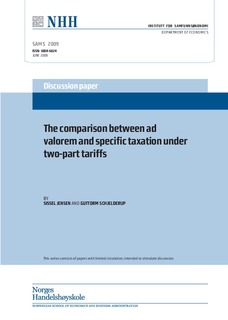| dc.contributor.author | Schjelderup, Guttorm | |
| dc.contributor.author | Jensen, Sissel | |
| dc.date.accessioned | 2009-07-27T12:09:48Z | |
| dc.date.available | 2009-07-27T12:09:48Z | |
| dc.date.issued | 2009-06 | |
| dc.identifier.issn | 0804-6824 | |
| dc.identifier.uri | http://hdl.handle.net/11250/163182 | |
| dc.description.abstract | In this paper, we compare ad valorem and specific taxation under heterogeneous
demand when a monopolist offers a menu of two-part tariffs.
An increase in either tax rate leads to a higher usage fee for all consumers,
whereas the fixed fee under reasonable assumptions will fall. If the government
changes the mix of taxes in such a way that the firm’s behavior is
unchanged, a system of wholly ad valorem taxation generates higher tax
revenue than does a system of wholly specific taxes. Tax reform designed
to leave tax revenue constant leads to a lower per usage fee and a higher
fixed fee for all consumers. It also increases market coverage, profits, tax
revenue, and the consumer surplus. | en |
| dc.language.iso | eng | en |
| dc.publisher | Norwegian School of Economics and Business Administration. Department of Economics | en |
| dc.relation.ispartofseries | Discussion paper | en |
| dc.relation.ispartofseries | 2009:5 | en |
| dc.subject | two-part tariffs | en |
| dc.subject | indirect taxation | en |
| dc.title | The comparison between ad valorem and specific taxation under two-part tariffs | en |
| dc.type | Working paper | en |
| dc.subject.nsi | VDP::Samfunnsvitenskap: 200::Økonomi: 210::Samfunnsøkonomi: 212 | en |
